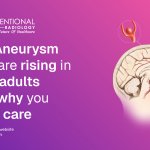When you think of brain aneurysms, you probably imagine a condition affecting older adults. But here’s the shocking reality — brain aneurysms are increasingly being detected in young adults under 40, and it’s time we start paying attention.
If you’re in your 20s or 30s and think, “This can’t happen to me,” — think again.
Let’s go in-depth into why this quiet menace is becoming an increasingly serious issue and how you should protect yourself.
What Exactly Is a Brain Aneurysm?
Simply put, a brain aneurysm is a bulge or swelling of a blood vessel in the brain. When it ruptures, it can cause a potentially fatal stroke, brain damage, or death.
The horrifying part?
Most aneurysms are symptomless until it’s too late.
Why Are Brain Aneurysms Increasing in Young Adults?
Recent research and concerning case reports indicate a significant increase in aneurysm cases among individuals under the age of 40. But why?
Here are some unexpected reasons:
Lifestyle Stress: High-stress jobs, hustle culture, and financial pressure are leading to high blood pressure — a major risk factor.
Unhealthy Habits: Smoking, heavy drinking, poor sleep, and inactivity are quietly harming blood vessels.
Undiagnosed Genetic Risks: Numerous young adults do not know about inherited conditions that raise aneurysm risk.
Increased Screen Time: Extended use of gadgets results in sedentary lifestyles, which harm vascular health.
Better Diagnostic Tools: Increasing numbers of young adults receive sophisticated imaging (MRI, CT scans) for unrelated complaints, resulting in incidental aneurysm detection.
Warning Signs You Should NEVER Ignore
Although most brain aneurysms remain silent, when they are present, symptoms may involve
Sudden, painful headache (referred to as the “worst headache of your life”)
Blurred or double vision
Stiff neck
Light sensitivity
Seizure
Drooping eyelid
Confusion or difficulty speaking
If you or someone around you are experiencing any of these — it’s a medical emergency. Seek immediate medical care. It can save a life.
How Can You Guard Yourself?
Know Your Family History
If anyone in your family has had an aneurysm or stroke, get screened ahead of time.
Control Your Blood Pressure
High BP is a huge trigger. Ongoing monitoring and control can lower risks by a lot.
Make a Brain-Healthy Lifestyle Choice
Stop smoking and cut back on alcohol.
Exercise regularly.
Get plenty of quality sleep.
Practice stress management with mindfulness, yoga, or hobbies.
Don’t Ignore Warning Signs
Mild headaches may not always be “just stress.” Pay attention to your body.
Annual Health Screenings
If you have risk factors, discuss with your doctor prevention brain scans.
It’s Time to Get Serious About Brain Health
Young adult brain aneurysms are real, on the increase, and potentially dangerous.
The good news: With awareness, lifestyle modification, and prompt medical care, many risks can be controlled or averted.
Your brain is your greatest asset.
Treat it like it counts — because it does, big time.
Stay conscious. Stay well. Stay brilliant.















